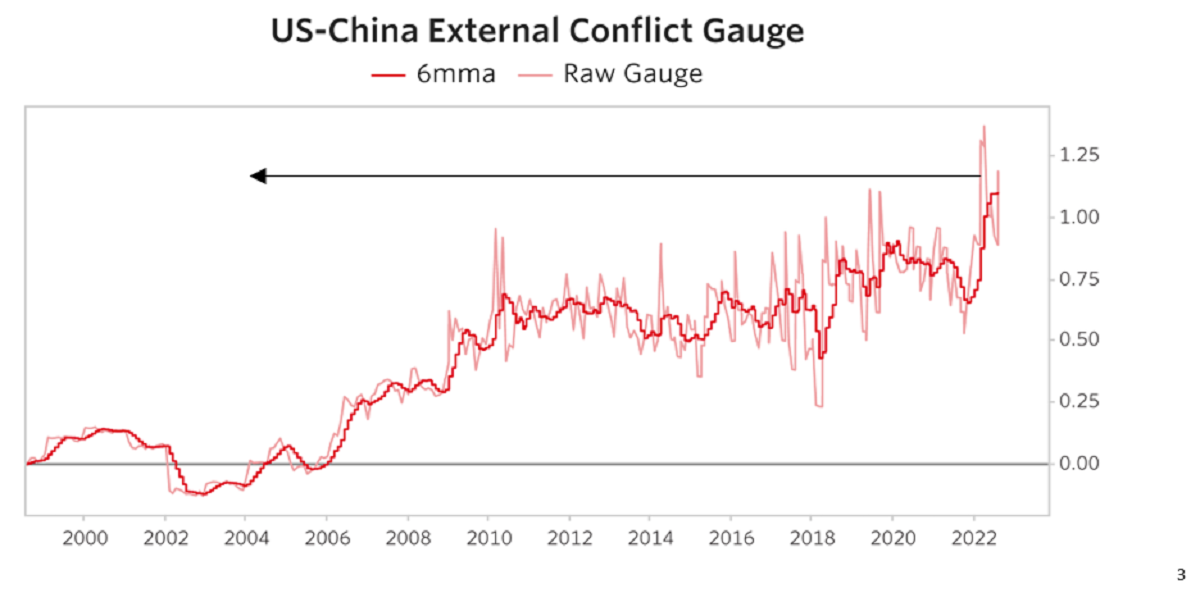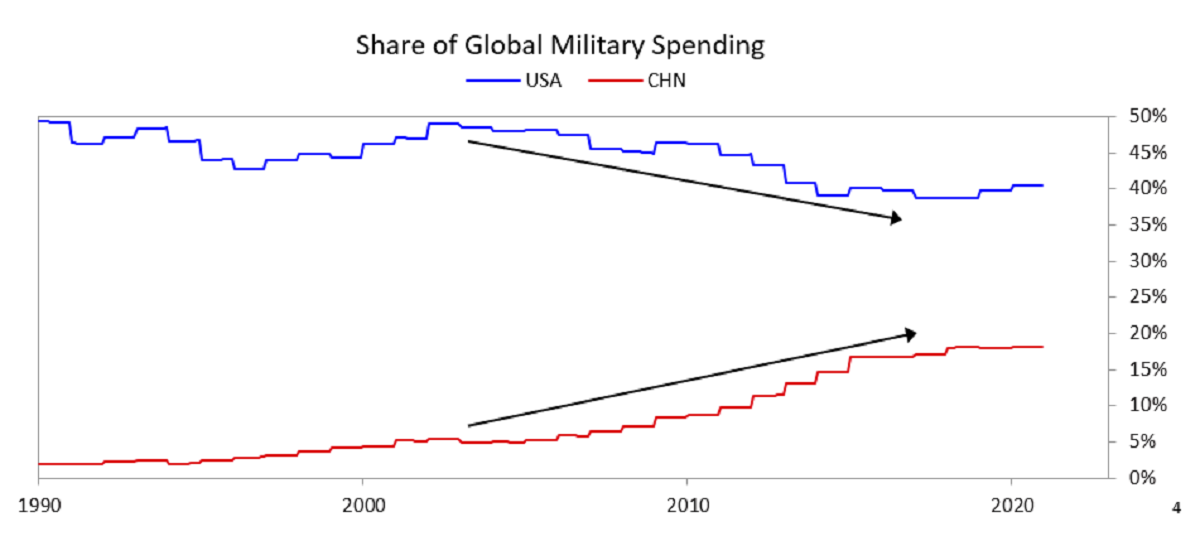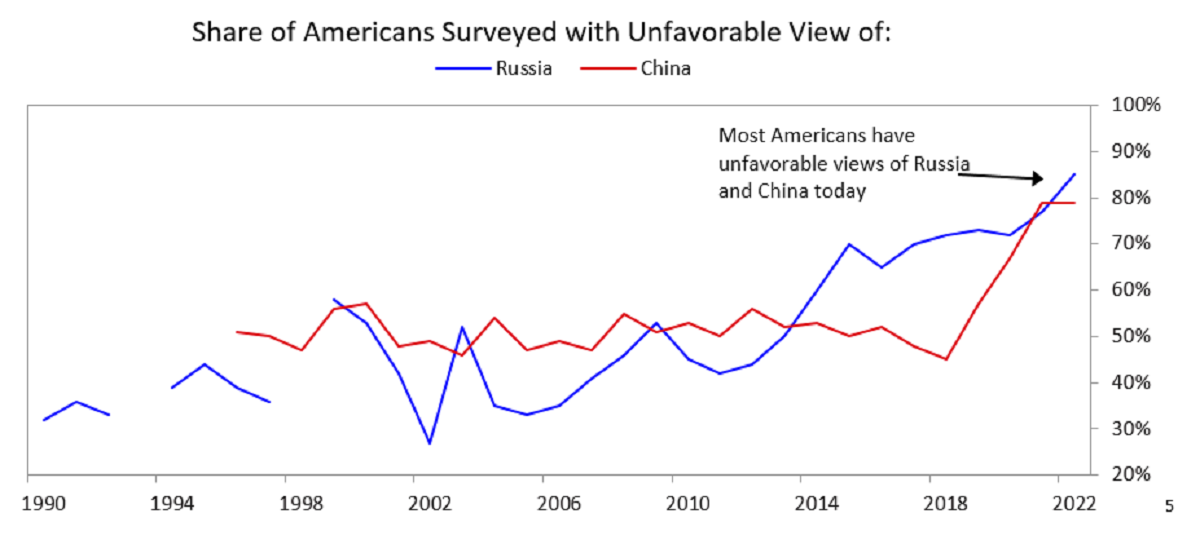Unfortunately, what is happening now between the US and China over Taiwan is following the classic path to war laid out in my book “Principles for Dealing with the Changing World Order.” If events continue to follow this path, this conflict will have a much larger global impact than the Russia-Ukraine war because it is between the world’s leading superpowers that are economically much larger and much more intertwined.
Q2 2022 hedge fund letters, conferences and more
For reasons previously explained, the Russia-Ukraine war is minor by comparison, though the two conflicts are related and the Russia-Ukraine war, like all wars, is having terrible consequences. For example, consider that China's share of world trade is over seven times larger than Russia's [1] and constitutes about 19% of all American manufactured goods imports. [2] Imagine if importing goods from China and doing business with China became the same as they are with Russia now. Imagine what the supply chain and economic impacts on the world would be. Imagine what sanctions on China would be like for the world. Supply chains would collapse, economic activity would dive, and inflation would soar. And that’s just what would happen to economies due to economic warfare which would pale in comparison to the impact that military warfare, which we are obviously dangerously close to, would have.
US-China Conflict Gauge
For reasons explained in my book, the situation that now exists between the United States and China is very similar to that which existed between powers immediately prior to World Wars I and II and many other immediate prewar periods. The chart below shows my US-China conflict gauge since 2000. As you can see, the readings for conflict between the US and China are the highest ever.
This index is composed of many indicators such as changes in military spending, personnel, and deployment; sentiment of each country's people about the other country; media attention given to the conflict, etc. The combination of military spending and attitudes toward each rival country has been particularly indicative. The chart below shows the shares of global military spending for the US and China which significantly understates China’s military spending because much government spending that supports the military is not included as direct military spending. Also, American military spending covers the world while Chinese military spending is more focused in the region. Knowledgeable parties tell me that China has significant military superiority around Taiwan.
The chart below plots recent Gallop poll data and shows that 80% of Americans now have an unfavorable view of China—which is now on par with how Americans view Russia (and is up meaningfully over the past few years).
To put the existing level of conflict between China and the US in perspective, the table below compares the current US-China conflict gauge reading to past readings of other great conflicts. As shown, the current reading for the US and China is nearly 1.2 standard deviations above the average, which is a reading in the high end of the range of major conflicts. While this conveys a high level and risk of conflict, it should not be misinterpreted to mean that a worsening is to come. Sometimes, these moments of heightened conflict are followed by a stepping back from war. For example, the period leading into the Cuban Missile Crisis had a relatively high reading of 0.9, but wise heads prevailed, so a potential disaster was avoided.
There are many more measures that convey the changing picture that are explained in my book which I don’t have the space to show you here, but will continue to plot along with the historical analogies I outlined in the book. I will use them to paint as accurate a picture as I can about what's happening and put it into an historical context. The dot plot will speak for itself as to which path we are on.
Closing Taiwan
As for what's now happening, the Chinese are responding to Nancy Pelosi’s visit by cutting off most relations and demonstrating that they can militarily control the area around Taiwan, which implies that China could shut Taiwan off from the rest of the world. Imagine that and its implications, e.g., imagine if semiconductor chips couldn't get out of Taiwan. China is also displaying its military power and it is crossing previously uncrossed lines of demarcation, thus closing in on Taiwan. [7]
Pelosi's visit was perceived by China as a move in favor of Taiwan's independence rather than toward one China with Taiwan part of China, and it is essentially challenging the US to stop it from doing what it is doing. The question is whether the US will respond with another escalation that will prompt another Chinese response, in the classic tit-for-tat acceleration into war, or if the sides will step back.
To gain a picture of the past and the forces that are driving the evolution of the US and China toward war (i.e. the Big Cycle) I suggest that you review Chapter 13 "US-China Relations and Wars." I suggest that you pay particular attention to my explanation of previous Taiwan Straits crises and why I said I would worry if we had a "Fourth Taiwan Crisis" which is the crisis that we are now having. To understand what is happening you must understand these things.
As I summarized on page 455 of that Chapter in the section "The Risk of Unnecessary War:" Stupid wars often happen as a result of a tit-for-tat escalation process in which responding to even small actions of an adversary is more important than being perceived as weak, especially when those on both sides don’t really understand the motivations of those on the other side. History shows us that this is especially a problem for declining empires, which tend to fight more than is logical because any retreat is seen as a defeat. Take the issue of Taiwan. Even though the US fighting to defend Taiwan would seem to be illogical, not fighting a Chinese attack on Taiwan might be perceived as being a big loss of stature and power over other countries that won’t support the US if it doesn’t fight and win for its allies. Additionally, such defeats can make leaders look weak to their own people, which can cost them the political support they need to remain in power. And, of course, miscalculations due to misunderstandings when conflicts are transpiring quickly are dangerous. All these dynamics create strong pulls toward wars accelerating even though such mutually destructive wars are so much worse than cooperating and competing in more peaceful ways. There is also risk of untruthful, emotional rhetoric taking hold in both the US and China, creating an atmosphere for escalation.
While the power of the forces behind the Big Cycle explained in "Principles for Dealing with the Changing World Order” can be overwhelming, people still have choices that will affect the outcomes. This conflict is still a low-grade military conflict (which I call a Category 2 military conflict) because 1) it has not yet produced an exchange of bloodshed of people from the two major sides i.e., Chinese and/or Americans and 2) it is not taking place on either country’s homeland (though the Chinese would say Taiwan is part of their homeland even though it’s not part of mainland China). If either of these were to change, that would be the next big step up toward unimaginable all-out war which I still consider improbable.
A good thing is that sensible people on both sides are scared of war even though they don’t want to look like they are. A bad thing is that some people on both sides want to intensify the fight because to not do so in the face of the provocation wound be perceived as a sign of weakness. That dynamic of upping the ante to avoid looking like one is backing down has throughout history been shown to be a very dangerous dynamic. We have seen many historic cases which have led to terrible wars because neither side wanted to back down and only few in which sensible people stepped back from the brink when faced with the prospect of unacceptable destruction.
My hope is that China’s escalation will not lead to the next US escalation which will lead to the next Chinese escalation which, despite the strong desire of sensible people on both sides to avoid war, would lead to a war. But hope is not a strategy, so I will try to be as realistic as possible, navigate accordingly, and communicate well with you.
Article by Ray Dalio, via LinkedIn
Footnotes
[1] China accounts for roughly 15% of global exports while Russia accounts for less than 2%. For example, see https://www.statista.com/topics/5947/trade-in-russia/ and https://unctad.org/news/china-rise-trade-titan [2] https://ustr.gov/countries-regions/china-mongolia-taiwan/peoples-republic-china [3] Note conflict gauge readings are shown as number of standard deviations from the average. [4] Based on internal calculations using data from SIPRI (https://www.sipri.org/databases/milex) [5] Source: Gallup (https://news.gallup.com/poll/1624/perceptions-foreign-countries.aspx) [6] Note conflict gauge readings are shown as number of standard deviations from the average. [7] For more detailed coverage of recent Chinese responses to Pelosi’s visit see https://www.ft.com/content/be6eca07-0f57-4aa4-a6af-58cc8bdc683f







